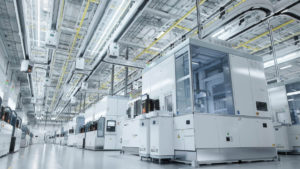The necessity to implement changes in the current layout of machines and equipment is often a crucial condition for improving the main and auxiliary production processes in factories. When changing locations, the relocation of production is broad and multi-process in nature, with a complex structure of responsibilities, a precise schedule, and diverse use of human and technical resources. So, what exactly is machine relocation? Learn more about the efficient movement of machines.

What Does Relocation Mean? Relocation – moving machines – involves actions related to changing the position of machines or equipment, whether within one facility or between two different locations, sometimes significantly distant from each other. The so-called location A (current) and location B (planned) can be 1000 meters apart or in different countries or even continents. The goal of the operation is not only to change the location, set up the machine, and prepare it for operation but primarily to ensure that the transferred unit will work just as well or even more efficiently in the new location. Machine relocation is an opportunity for improvements and higher efficiency. What is Relocation in Operational Terms? It is a series of activities planned and executed according to the relocation plan, among which the most important can be mentioned: task verification, planning, disconnecting the machine from utilities, dismantling, packing and preparing for transport, transportation, assembly of equipment in a pre-prepared place with access to utilities, preparation for startup, and often completion of startup documentation (CE, machinery directives, instructions, etc.). Regardless of the complexity, every relocation requires extensive technical knowledge and experience to optimally select equipment resources and secure risk areas that need to be identified in advance. An example of a particularly complex operation can be the relocation of machines while maintaining the continuity of the plant’s production. The experience of the relocation company, good coordination with the production plant, and a detailed action plan can guarantee the success of such an undertaking. Stages of Machine Relocation Verification of Relocation: Machine relocations take into account many factors identified during the verification stage, including visits, interviews, and measurements at locations A and B. The conclusions and information obtained during the feasibility study, combined with the analysis of technical documentation of the relocated equipment, form the basis for creating a precise relocation plan. Relocation Plan: The relocation company undertaking the task of moving production infrastructure prepares a precise relocation plan based on the sum of information from verification and their own experience, which must indicate:
- the course (order and nature) of operations
- the schedule of planned activities
- necessary resources including backups
- identified areas of responsibility
- a risk map and a list of protective measures
- critical and specific conditions for the relocation of the indicated equipment
- requirements for startup
The primary risks arising from an improperly prepared relocation plan (incomplete or operationally incorrect) include exceeding the schedule, interrupting production continuity, increasing relocation operation costs, property damage, and reduced efficiency of equipment in the new location. Dismantling of Machines: The dismantling operation comprises several sub-processes: labeling elements and connections, disconnecting utilities, technical dismantling, preparing for transport (e.g., removing technical fluids), selecting groups for packing and transport with a description of sets. The so-called “breaking” of the machine must be done according to the relocation plan within a precisely defined timeframe, as this moment determines the next transfer operations. Loading and Transport: Labeled and secured machine parts/components are packed according to the specifications of transport conditions, considering weight, dimensions, sensitivity to external conditions and stimuli, and the method of transport (means and route of movement). For example, sea freight requires special packaging that fully protects against the effects of sea salt on the transported cargo, and road transport of oversized loads requires preparing transport documentation, obtaining permits, and implementing security measures. An indispensable element of transport, although concerning the entire relocation operation, is full insurance of the transported property for its value as well as the consequences of possible actions (damage) during transport. Preparation of the New Location: Depending on the needs and scope, the operation of preparing location B (transport routes, substrate, foundation, oil pits, new utilities) must be carried out early enough (according to plan) so that the new environment is fully ready in time for the delivery of the relocated equipment. Only such coordination effectively reduces downtime and related costs. Machine relocation is an optimally timed process, most often minimized as much as possible. Unloading and Assembly of Machines: Assembly is, in the simplest terms, the reverse execution of dismantling activities according to the labels. However, in many cases, assembly means modifying settings considering the conditions of the new location and the postulate of better efficiency. Assembly performed by specialists can be extended to include maintenance work, minor repairs, or even setting modifications. Machine Startup: The entire machine relocation operation is completed by its startup, which consists of several stages, such as connecting and technical acceptance of utilities, performing startup and production tests, and completing startup documentation. The standard assumption of machine relocation is that in the new location, they will work equally or even more efficiently. Safety issues both in terms of technical resources and protecting the life and health of employees are beyond discussion. Comprehensive Nature of Machine Relocation Successfully conducted machine relocation means meeting several conditions:
- Safe transfer of production infrastructure for property and surroundings
- Technical and formal startup of relocated equipment in the new place
- No reduction in efficiency and quality in the new environment
- Execution of relocation according to the operation plan, schedule, and budget
A condition conducive to safe machine relocation is entrusting the entire task to one technically prepared experienced relocation company. Then the investor gains several benefits:
- No conflicts at the responsibility areas interfaces
- Simplified communication and coordination with one contractor
- Optimization of relocation processes by the selected contractor does not threaten production continuity, reducing downtime periods to a necessary minimum.


